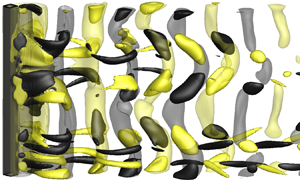Published online by Cambridge University Press: 14 May 2021

Three-dimensional (3-D) wake transition for flow past a diamond cylinder is investigated numerically. Detailed 3-D direct numerical simulations (DNS) show that the wake is represented by mode A with global vortex dislocations for Reynolds numbers Re = 121–150, followed by a mode swapping between modes A and B for Re = 160–210 and increasingly disordered mode B for Re ≥ 220. In the mode swapping regime, different characteristics of the dislocation and non-dislocation periods are revealed by decomposing flow properties (e.g. the root-mean-square lift coefficient) into the values corresponding to the dislocation and non-dislocation periods. Such decomposition helps to explain some major differences observed for the cases of a diamond and a circular cylinder. In addition to DNS, Floquet stability analyses are conducted to identify the 3-D wake instability modes of a diamond cylinder up to Re = 300. Phase-averaged base flow is used to eliminate the quantitative uncertainties induced by the aperiodic secondary vortex street of the base flow. Interestingly, a subharmonic instability mode is identified at Re ≥ 285, whereas mode B is absent. The origin of the subharmonic mode is explained. The disagreement between the DNS and the Floquet analysis regarding the existence of mode B and the subharmonic mode is also explained. It is found that the natural 3-D flow involves complex interactions between the streamwise and spanwise vortices, as well as between the 3-D wake transition and the two-dimensional base-flow transition, which excite mode B and suppress the subharmonic mode.